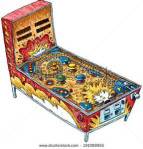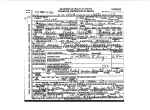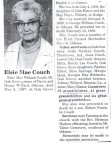 When I first began researching my family history, somewhere in the back of my mind I believed that one day I would finish my search. I know I thought that 20+ years ago. Planning that after I finished the research, I could start writing the stories of my ancestors. Today I know that I am nowhere near the end of my family history. I have always had the desire to put together a book with these stories to pass on to my Grandchildren. How should I start?
When I first began researching my family history, somewhere in the back of my mind I believed that one day I would finish my search. I know I thought that 20+ years ago. Planning that after I finished the research, I could start writing the stories of my ancestors. Today I know that I am nowhere near the end of my family history. I have always had the desire to put together a book with these stories to pass on to my Grandchildren. How should I start?
Waiting is a mistake. Looking through our trees we can see so many Ancestors we want to write about but thinking about that prospect is overwhelming. There may be lots of material to glean from but who should you start with? Should you do it in order, current to ancient? How much or how little information should you include?
So, how do we even begin? Here are some hints I have been using that may help.

1, Since there is not just one straight line stretching back to an original ancestor, you can actually start anywhere. There are many trees and branches to choose from. Where you begin and with whom you write about is up to you.
I started with my Maternal Great Grandparents. My Great Grandpa ends his line. I can find no information on his birth or death, only his marriage to my Great Grandma and the birth of my Grandpa. However, I have a few stories that I heard about him while growing up and I wrote about those. If I find anything in the future about him, I can always add it. My Great Grandma was a different case. Her lineage goes back to my 11th Great Grandfather born ABT 1606 in Uxenden, Middlesex, England.
2, Don’t stress over writing a perfect story. Just start writing down what you know about your ancestor. Basically, just get it on paper. You can always go back and fill in the information, make corrections and add details.
As the author of 3 books, I know the struggle with trying to write something that is presentable. Over the last 5 years I discovered that if I just write what comes to me, I at least have something to work with. Editing, grammar, spelling, rewriting, etc. can be done when the writing is finished.
 3. Don’t get caught in the belief that you don’t have time to write a story. Everyone makes time for the things that are important to them. You can begin by setting aside 30 minutes during your day to sit down and write.
3. Don’t get caught in the belief that you don’t have time to write a story. Everyone makes time for the things that are important to them. You can begin by setting aside 30 minutes during your day to sit down and write.
I know with the responsibilities of life it is sometimes hard to fit anything into our schedules. But like everything else, if you really want to do it then you will find the time.
4. It is okay to write a partial story. If you begin writing about one of your ancestors and you find you don’t feel like what you are writing isn’t interesting, then it is okay to stop writing. You can save what you do have and return to it at a later time, This allows you to approach it with a new perspective and perhaps some additional research.
5. If you are so inclined, include some historical context to your stories. You can write about what life may have been like during their lifetime, a short history of the area they lived in or some event that happened in the world at that time.
6. In writing stories of your family history, it is important not to forget about yourself! By the time your children or grandchildren read what you have written, you will have become one of those “ancestors”. It would be such a great gift to have an accurate, first-hand account of your life to pass on. You may include anything you feel you would like your descendants to know about you and your life. In other words, the good, the bad and the ugly.
the time your children or grandchildren read what you have written, you will have become one of those “ancestors”. It would be such a great gift to have an accurate, first-hand account of your life to pass on. You may include anything you feel you would like your descendants to know about you and your life. In other words, the good, the bad and the ugly.
About 10 years ago I read a book about writing your own story, In it was ideas of what to write. Things like “tell me about your elementary school days”, “what did you like to do in your spare time or “what hobbies did you have” and “what type of pets did you have growing up”. These were great to get the mind thinking and you only had to write about one aspect of your life at a time. You didn’t have to put it in chronological order or stress over little details.
The reason for this blog is to encourage you to write those stories about your ancestors. Not all of us have been blessed by someone else taking the time to do it. It would be a great legacy to pass on to future generations. I know I would have loved for some ancestors of mine to have preserved some stories that I could read.
 I am a professional genealogist, writer, photographer, crafter, reader, wife, mother, and grandma. I have two books available on Amazon.com: http://tinyurl.com/Your-Family-History and http://tinyurl.com/Genealogy-Research-Trip. You can also connect with me via Facebook or Twitter.
I am a professional genealogist, writer, photographer, crafter, reader, wife, mother, and grandma. I have two books available on Amazon.com: http://tinyurl.com/Your-Family-History and http://tinyurl.com/Genealogy-Research-Trip. You can also connect with me via Facebook or Twitter.


 I am a professional genealogist, writer, photographer, crafter, reader, wife, mother, and grandma. I have two books available on Amazon.com:
I am a professional genealogist, writer, photographer, crafter, reader, wife, mother, and grandma. I have two books available on Amazon.com:  If we are to be honest it is hard to resist rushing through our research in the effort to go back one more generation. Especially when we find that next ancestor while doing the research. It is exciting to see how far back we can go and what interesting facts or stories we may find. Sometimes we abandon a “brick wall” ancestor to pursue an easier line.
If we are to be honest it is hard to resist rushing through our research in the effort to go back one more generation. Especially when we find that next ancestor while doing the research. It is exciting to see how far back we can go and what interesting facts or stories we may find. Sometimes we abandon a “brick wall” ancestor to pursue an easier line. Missouri and when I walked in her house I was both impressed and jealous. She had been researching our mutual family for over 40 years. She had worked for the State Historical Society in Jefferson City for over 30 years and she had been able to search to her heart’s content. She had dozens of file cabinets and binders full of documentation. I took her word without hesitation.
Missouri and when I walked in her house I was both impressed and jealous. She had been researching our mutual family for over 40 years. She had worked for the State Historical Society in Jefferson City for over 30 years and she had been able to search to her heart’s content. She had dozens of file cabinets and binders full of documentation. I took her word without hesitation. I decided to take a different approach this time. I would start with the son and see what came up. I use more than Ancestry.com to do research so I pulled up all the sites. I found a Civil War Union Army document that had Greenbury’s name and place of birth that matched mine. It also listed his parents name as Augustine White born in Virginia and Margaret McClain born in Kentucky. With a little more research I found their marriage information and census records that listed the names of their children which matched mine. In no time I had the dates for their marriage, their places of birth, additional children’s names and the places they had lived. This opened even more doors of info which gave me possible names for their parents. My cousin had Augustine’s first name wrong, but once I discovered his correct name it busted through that brick wall.
I decided to take a different approach this time. I would start with the son and see what came up. I use more than Ancestry.com to do research so I pulled up all the sites. I found a Civil War Union Army document that had Greenbury’s name and place of birth that matched mine. It also listed his parents name as Augustine White born in Virginia and Margaret McClain born in Kentucky. With a little more research I found their marriage information and census records that listed the names of their children which matched mine. In no time I had the dates for their marriage, their places of birth, additional children’s names and the places they had lived. This opened even more doors of info which gave me possible names for their parents. My cousin had Augustine’s first name wrong, but once I discovered his correct name it busted through that brick wall. I am a professional genealogist, writer, photographer, crafter, reader, wife, mother, and grandma. I have two books available on Amazon.com:
I am a professional genealogist, writer, photographer, crafter, reader, wife, mother, and grandma. I have two books available on Amazon.com:  I have been doing Genealogy for over 20 years. I am the first to confess that I am far from knowing everything about it and the processes to make those great discoveries. I have no problem when someone wants to share their knowledge with me, I do however mind if their “knowledge” has no basis and the person who shares it hasn’t even verified what they are passing along.
I have been doing Genealogy for over 20 years. I am the first to confess that I am far from knowing everything about it and the processes to make those great discoveries. I have no problem when someone wants to share their knowledge with me, I do however mind if their “knowledge” has no basis and the person who shares it hasn’t even verified what they are passing along. Case in point. I am very proud of my maternal 4th Great Grandmother, Permelia “Milly” Loving Allen. She was a very strong woman who, at the age of 67 moved her large family from Cole County Missouri to Navarro, Tarrant County, Texas after the death of her husband in 1843. In my family tree on Ancestry, I have 3 photos of Permelia, one of her, one of her and a daughter and one of her and her husband Thomas Allen taken in 1840.
Case in point. I am very proud of my maternal 4th Great Grandmother, Permelia “Milly” Loving Allen. She was a very strong woman who, at the age of 67 moved her large family from Cole County Missouri to Navarro, Tarrant County, Texas after the death of her husband in 1843. In my family tree on Ancestry, I have 3 photos of Permelia, one of her, one of her and a daughter and one of her and her husband Thomas Allen taken in 1840. So, I decided I would thank her for her comments and then educate her, in a nice way, about the invention of photography.
So, I decided I would thank her for her comments and then educate her, in a nice way, about the invention of photography. grandma. I have two books available on Amazon.com:
grandma. I have two books available on Amazon.com:  I got one of those “shaky leaf’s” attached to an ancestor on my Mothers’ side. It led to another one, then another one and soon I was making an unsettling discovery. Apparently, I had grossly neglected cleaning up this side of the family! I spent many hours deleting name after name! As I was doing this I found that not only had I added unsubstantiated ancestors but also people who were not even related to me. I have read lots of posts about these but I had never seen any before. Here are 4 that I found.
I got one of those “shaky leaf’s” attached to an ancestor on my Mothers’ side. It led to another one, then another one and soon I was making an unsettling discovery. Apparently, I had grossly neglected cleaning up this side of the family! I spent many hours deleting name after name! As I was doing this I found that not only had I added unsubstantiated ancestors but also people who were not even related to me. I have read lots of posts about these but I had never seen any before. Here are 4 that I found. I really wish I would have known about not adding information that have no proof or sources cited to my trees. It was a good lesson to learn and I gladly pass it on to anyone who will listen.
I really wish I would have known about not adding information that have no proof or sources cited to my trees. It was a good lesson to learn and I gladly pass it on to anyone who will listen. I am a professional genealogist, writer, photographer, crafter, reader, wife, mother, and grandma. I have two books available on Amazon.com:
I am a professional genealogist, writer, photographer, crafter, reader, wife, mother, and grandma. I have two books available on Amazon.com:  It is always amazing to see how much society has changed in the last few hundred years. What is the “norm” for today was taboo a century ago and what was accepted 200 years ago seems unimaginable today. Throughout history there has always been a “Hot Topic” in each generation. Topics such as the Suffrage Movement, Religious Freedoms, Slavery, Prohibition, Wars etc. Today we are hard pressed to find out how our ancestors felt about these issues or if any of them actively supported or opposed them. Unless our ancestor was “famous” for their stand we may never know.
It is always amazing to see how much society has changed in the last few hundred years. What is the “norm” for today was taboo a century ago and what was accepted 200 years ago seems unimaginable today. Throughout history there has always been a “Hot Topic” in each generation. Topics such as the Suffrage Movement, Religious Freedoms, Slavery, Prohibition, Wars etc. Today we are hard pressed to find out how our ancestors felt about these issues or if any of them actively supported or opposed them. Unless our ancestor was “famous” for their stand we may never know. the Civil War. If your ancestor fought for the North, you can assume they were anti-slavery and if they fought for the South they were pro-slavery. Also if they owned slaves you can assume that they believed in it and if they didn’t they were opposed. Some of the “topics” were not so obvious.
the Civil War. If your ancestor fought for the North, you can assume they were anti-slavery and if they fought for the South they were pro-slavery. Also if they owned slaves you can assume that they believed in it and if they didn’t they were opposed. Some of the “topics” were not so obvious. I am of the belief that I want to leave as much information for our future generations as possible. Not only about our ancestral line but also of the times in which we live. I have started writing about some of my beliefs, my stands on social issues and any participation’s I have had for or against those issues. To be quite honest I have picketed for one issue and I have picketed against another. I have participated in rallies and marches. I have appeared on local and National television, radio programs, been a Conference Speaker and featured in magazines and newspapers as an expert on one issue. I want my Great Grand-kids to know their Great Grandma held strong opinions on certain subjects and she wasn’t afraid to let others know how she felt. I am trying to be fair and explain both sides of the issues and express why I chose the side I did.
I am of the belief that I want to leave as much information for our future generations as possible. Not only about our ancestral line but also of the times in which we live. I have started writing about some of my beliefs, my stands on social issues and any participation’s I have had for or against those issues. To be quite honest I have picketed for one issue and I have picketed against another. I have participated in rallies and marches. I have appeared on local and National television, radio programs, been a Conference Speaker and featured in magazines and newspapers as an expert on one issue. I want my Great Grand-kids to know their Great Grandma held strong opinions on certain subjects and she wasn’t afraid to let others know how she felt. I am trying to be fair and explain both sides of the issues and express why I chose the side I did.











